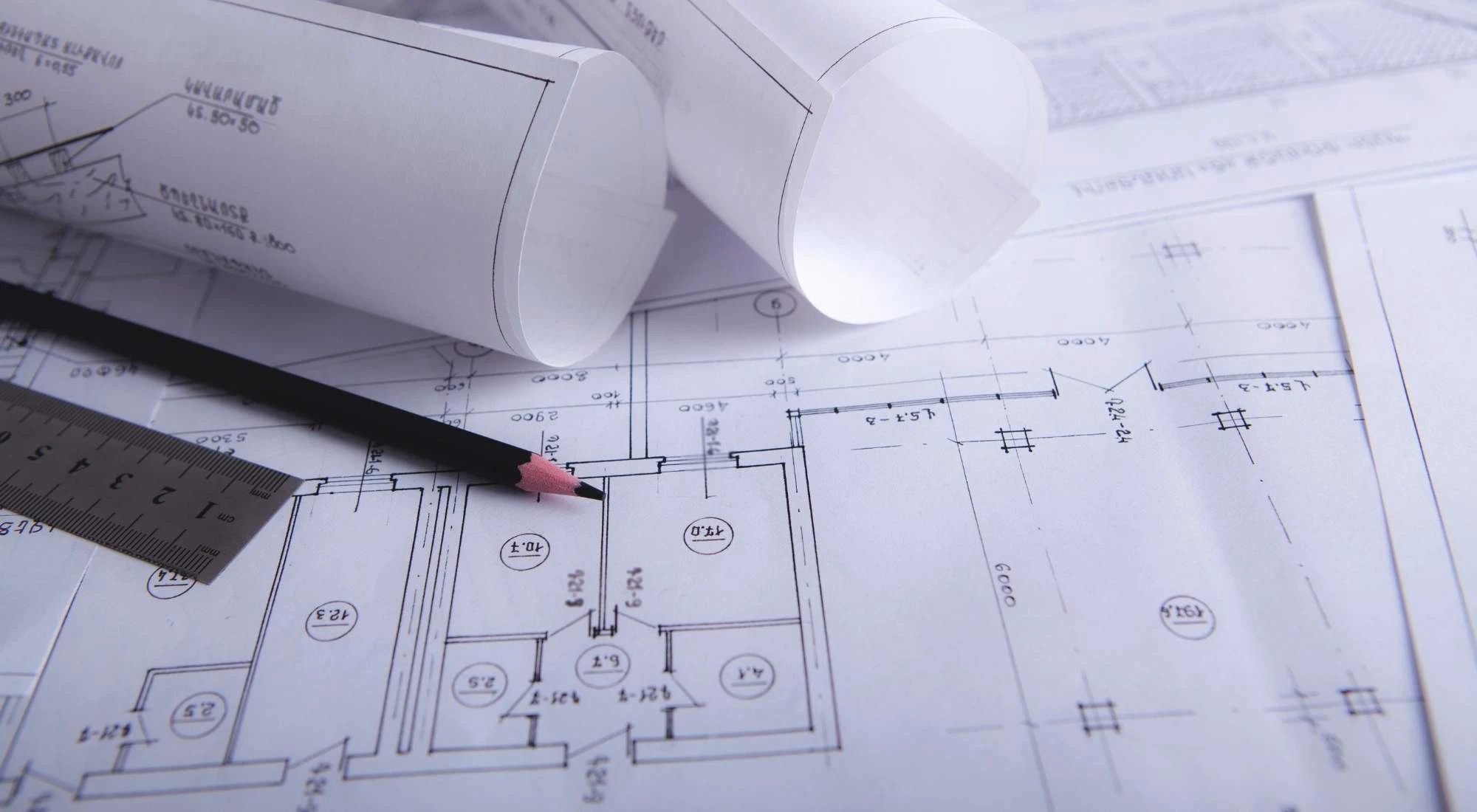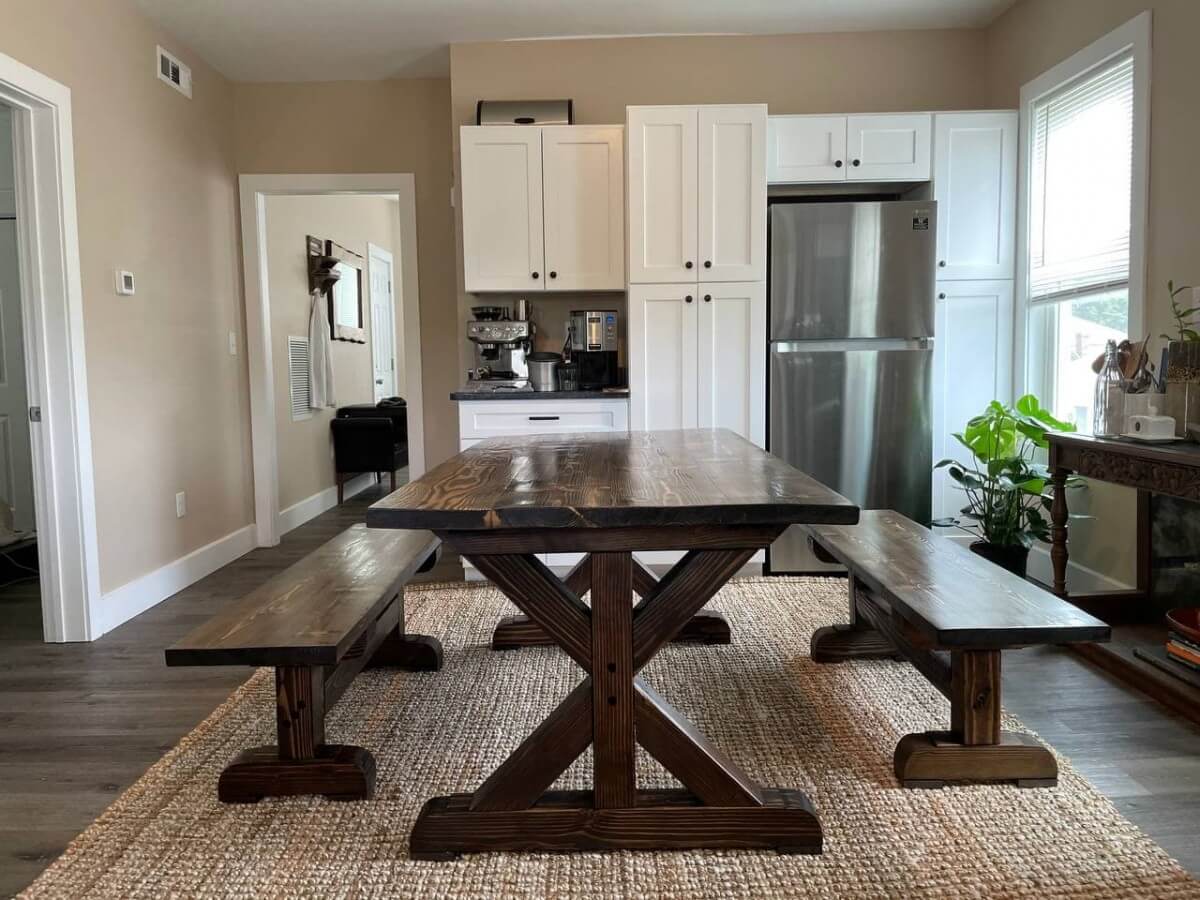Home>diy>Building & Construction>What Is A Set Of Residential Construction Documents


Building & Construction
What Is A Set Of Residential Construction Documents
Modified: March 6, 2024
Learn about the importance of residential construction documents for building-construction projects. Find out what these documents entail and how they contribute to successful construction processes.
(Many of the links in this article redirect to a specific reviewed product. Your purchase of these products through affiliate links helps to generate commission for Storables.com, at no extra cost. Learn more)
Introduction
When it comes to building a residential structure, there are many crucial steps involved to ensure a successful and safe construction process. One of the key elements in this journey is the creation and utilization of residential construction documents. These documents are essential blueprints that guide and document every aspect of the construction project.
Residential construction documents serve as a communication tool between the architect, engineer, contractor, and other stakeholders involved in the project. They provide a detailed representation of the design, dimensions, materials, and specifications required to construct a residential building.
In this article, we will delve into the world of residential construction documents, exploring their definition, purpose, and various types. By understanding the importance and content of these documents, you will gain a holistic understanding of the construction process and the vital role these documents play.
Key Takeaways:
- Residential construction documents are like detailed blueprints that guide the construction of homes. They include floor plans, elevations, and specifications, ensuring safety, compliance, and successful building projects.
- Each type of construction document, from electrical plans to landscape plans, plays a crucial role in creating safe, efficient, and visually appealing residential buildings. These documents are essential for communication, coordination, and compliance.
Read more: What Is Tender Document In Construction
Definition of Residential Construction Documents
Residential construction documents, also known as construction drawings or blueprints, are a comprehensive set of technical documents that outline the exact specifications for building a residential structure. These documents act as a guide for the construction team, providing them with the necessary information to execute the project accurately and efficiently.
The construction documents consist of detailed illustrations, measurements, and instructions that encompass various aspects of the construction project, including architectural, structural, electrical, plumbing, HVAC (heating, ventilation, and air conditioning), and landscaping components. These documents essentially serve as a roadmap, communicating the design intent and technical requirements to everyone involved in the project.
Typically, the construction documents include several types of drawings, such as floor plans, elevations, sections, details, and engineering drawings. They also encompass specifications, schedules, notes, and any other relevant information pertaining to the construction process.
The level of detail and complexity within the construction documents can vary depending on the size and complexity of the residential project. Larger and more intricate structures will require more comprehensive and detailed documentation to ensure a smooth construction process.
It is important to note that residential construction documents are legal and binding contracts between the homeowner and the construction team. They serve as a reference point to ensure that the finished project meets all the agreed-upon specifications and requirements.
Now that we have established the definition of residential construction documents, let us explore their purpose in the next section.
Purpose of Residential Construction Documents
The primary purpose of residential construction documents is to provide a clear and detailed representation of the design and specifications for the construction of a residential building. These documents serve as a bridge between the envisioning phase and the actual construction phase of a project, ensuring that the vision of the architect and the needs of the homeowner are accurately translated into a tangible structure.
Here are some specific purposes of residential construction documents:
1. Communication and Collaboration: Construction documents act as a universal language that facilitates effective communication and collaboration between all stakeholders involved in the project. They provide a standardized format for conveying design intent, technical information, and construction requirements to architects, engineers, contractors, subcontractors, and suppliers.
2. Legal and Contractual Compliance: Construction documents serve as legally binding documents that establish the agreed-upon specifications and requirements for the construction project. They provide a benchmark against which the progress and quality of the construction can be measured. They also serve as evidence in case of disputes or discrepancies that may arise during the construction process.
3. Construction Direction: These documents provide detailed instructions and guidance to the construction team, informing them of the materials to be used, the techniques to be employed, and the sequencing of construction activities. They ensure that the construction process follows the approved plan, reducing the likelihood of errors and rework.
4. Building Code Compliance: Residential construction documents incorporate building codes and regulations, ensuring that the structure meets all the necessary safety and regulatory standards. They outline the required dimensions, clearances, structural elements, electrical and plumbing systems, and other essential aspects that are crucial for obtaining building permits and passing inspections.
5. Cost Estimation and Material Procurement: Construction documents assist in estimating the cost of materials and services required for the project. They provide detailed information on the quantities and specifications of materials, enabling accurate budgeting and procurement planning.
By serving these purposes, residential construction documents provide a roadmap for the successful execution of the construction project, minimizing errors, streamlining the construction process, and ensuring compliance with legal and safety standards.
Next, we will explore the various types of residential construction documents in more detail.
Types of Residential Construction Documents
Residential construction documents comprise various types of drawings, specifications, schedules, and other detailed information that collectively provide a comprehensive guide for the construction process. Let’s explore the key types of residential construction documents:
1. Floor Plans: Floor plans are the most fundamental and commonly-used construction documents. They present a bird’s-eye view of each floor of the residential building, illustrating the layout and dimensions of rooms, walls, doors, windows, and other architectural features. Floor plans help visualize the flow and functionality of the space and serve as a reference for the placement of furniture and fixtures.
2. Elevations: Elevations are drawings that depict the exterior views of the residential structure from different angles. They showcase the building’s façade, including architectural elements such as windows, doors, rooflines, and exterior finishes. Elevations provide a detailed understanding of the building’s overall aesthetic and design.
3. Sections: Sections are vertical cutaway views of the building that provide a detailed representation of the interior design and construction elements. They show the relationship between different floors, wall heights, structural components, and the placement of stairs. Sections provide a deeper understanding of the internal structure of the building.
4. Details: Details are specialized drawings that focus on specific areas or components of the construction project. They provide close-up views and enlarged drawings to highlight specific construction techniques, connections, or complex design elements. Details help ensure accurate construction and clarity in implementing specific building features.
5. Specifications: Specifications outline the technical requirements for materials, finishes, equipment, and construction methodology. They include information about the quality, size, installation guidelines, and performance standards of each element in the project. Specifications ensure consistency in materials and processes, ensuring that the construction meets the desired standards.
6. Schedules: Schedules provide a tabulated format that lists the specific items, materials, or equipment required for the construction project. They detail quantities, dimensions, specifications, and any other relevant information. Common schedules include door and window schedules, finish schedules, and fixture schedules.
7. Notes: Notes are written instructions or clarifications included within the construction documents. They provide important information that may not be visually represented in the drawings, such as construction techniques, safety requirements, or specific instructions from the architect or engineer.
These are some of the key types of residential construction documents. Additionally, depending on the project scope, other documents such as engineering drawings, electrical plans, plumbing plans, HVAC plans, landscape plans, and permit drawings may also be included.
Now that we have explored the various types of residential construction documents, we can appreciate the level of detail and specificity that goes into creating these documents. In the next section, we will discuss the significance of each type of construction document in more depth.
Site Plan
A site plan is a critical component of residential construction documents that provides an overview of the entire property on which the residential structure will be built. It outlines the placement of the building on the site and includes important details related to landscaping, utilities, and access points.
The site plan takes into account factors such as topography, existing structures, vegetation, and site boundaries. It showcases the positioning of the residential building in relation to property lines, setbacks, and other site constraints or requirements imposed by local building codes or zoning regulations.
In addition to the building footprint, a site plan also includes information about driveways, walkways, parking areas, and other paved surfaces. It indicates the location of utilities, including water lines, sewer lines, electrical connections, and gas lines. This information helps ensure that these services are properly integrated into the construction process and that any necessary permits can be obtained.
Furthermore, a site plan includes details related to landscaping elements such as trees, shrubs, and other vegetation. It shows the proposed location of outdoor amenities like patios, decks, and swimming pools. Landscaping features are carefully incorporated into the site plan to enhance the aesthetics, functionality, and sustainability of the residential property.
Site plans are crucial for obtaining building permits, as they demonstrate compliance with site-specific regulations and requirements. They also serve as a valuable tool for contractors, helping them understand the unique aspects of the site and plan the construction activities accordingly.
In summary, a site plan is an essential document within the residential construction documents set that provides an overall view of the property and addresses critical factors such as site constraints, utility connections, and landscaping elements. It acts as a reference for planning and executing the construction process accurately and complying with local regulations.
Next, we will explore the importance of floor plans in residential construction documents.
Read more: How To Get Into Residential Construction
Floor Plans
Floor plans are an integral component of residential construction documents, providing a detailed visual representation of each floor of the residential building. These plans showcase the layout and dimensions of rooms, walls, windows, doors, and other architectural elements from a top-down perspective.
One of the primary purposes of floor plans is to help homeowners and stakeholders visualize the flow of the space and understand the overall layout of the residence. They illustrate the arrangement of different rooms, such as bedrooms, bathrooms, living areas, and kitchens, as well as the location and size of hallways, stairways, and closets.
Each room in a floor plan is typically labeled with dimensions, indicating the precise measurements of the space. This information is crucial for the construction team to accurately execute the design and ensure that the final structure matches the intended layout.
Moreover, floor plans provide essential information for interior design and space planning. Homeowners and interior designers use these plans to determine furniture placement, identify areas for functional use, and create an optimal living environment. They also assist in evaluating the feasibility and efficiency of the floor layout, allowing for adjustments or modifications as needed.
Additionally, floor plans help in assessing the flow and function of the home in terms of daily activities and accessibility. They reveal the relationships between various rooms and highlight any potential issues, such as cramped spaces or inefficient traffic flow.
For the construction team, floor plans act as a guide during the construction process. They provide clear instructions on where walls, windows, doors, and other architectural features should be located. Contractors and subcontractors can refer to the floor plans to understand the scope of work and coordinate their respective tasks.
Overall, floor plans are an essential component of residential construction documents, offering a comprehensive and visual representation of the home’s layout and dimensions. They serve as a blueprint for construction and interior design decisions, ensuring that the final residential structure meets the design and functional requirements.
Next, we will explore the significance of elevations in residential construction documents.
Elevations
Elevations are a crucial part of residential construction documents, providing a detailed visual representation of the exterior views of the residential structure from various angles. These drawings showcase the architectural features, proportions, and design elements that define the building’s facade.
Elevations help homeowners, architects, and contractors understand the overall aesthetic and appearance of the residential building. They depict the external finishes, materials, and details such as windows, doors, rooflines, and architectural embellishments.
One of the primary purposes of elevations is to convey the design intent and ensure that the visual elements of the building meet the desired aesthetic goals. They capture the unique architectural style, whether it is traditional, modern, contemporary, or a blend of various influences.
Elevations provide important information for the construction team, guiding them during the construction phase. Contractors refer to the elevations to accurately implement the design and ensure that the building’s exterior reflects the architect’s vision. They help determine the correct placement, sizing, and detailing of architectural elements, ensuring consistency and quality in the construction process.
In addition to aesthetics, elevations offer practical benefits. They provide crucial information for the installation of exterior finishes, including siding, stucco, brickwork, or cladding materials. They also indicate the position and style of windows and doors, helping to confirm compliance with building codes and energy efficiency requirements.
Elevations are invaluable tools for obtaining planning permissions and permits. Local authorities and building inspectors use them to assess the visual impact of the proposed residential building on the surrounding area. They help ensure that the design aligns with zoning regulations and architectural guidelines, and that the building blends harmoniously with the neighborhood’s character.
Furthermore, elevations aid in the evaluation and coordination of other design elements, such as landscaping and site features. They assist in determining the optimal placement of outdoor amenities such as balconies, porches, or decks, and how they contribute to the overall aesthetic appeal of the residential structure.
In summary, elevations play a crucial role in residential construction documents, providing a detailed representation of the exterior views of the building. They communicate the design intent, guide the construction process, facilitate compliance with regulations, and ensure the visual harmony of the residential structure.
Next, we will explore the significance of sections in residential construction documents.
Sections
Sections are a vital component of residential construction documents, providing a vertical cutaway view of the residential building. These drawings depict a cross-section of the structure, revealing important details about the interior design, construction elements, and spatial relationships.
Sections play a crucial role in helping homeowners, architects, and contractors understand the internal composition of the residential building. They provide a deeper insight into the arrangement of walls, floors, ceilings, and other structural components.
One of the primary purposes of sections is to showcase the vertical dimensions and relationships within the building. They allow stakeholders to visualize the height of the ceilings, the distribution of different levels or stories, and the relative positioning of rooms and spaces.
Sections provide essential information for coordinating and integrating various building systems. They illustrate the placement of electrical, plumbing, and HVAC (heating, ventilation, and air conditioning) components, as well as the routing of ductwork, pipes, and conduits. This information aids in the efficient and effective installation of these systems during the construction process.
Furthermore, sections help assess any potential conflicts or compatibility issues between different systems or structural elements. They help identify areas where adjustments or modifications might be necessary to ensure the smooth integration of these components.
Sections are critical for understanding the structural integrity of the residential building. They reveal the type of construction, the size and spacing of structural members such as beams, columns, and load-bearing walls. They also indicate the presence of insulation materials and their placement. This information is invaluable for ensuring that the building meets safety standards and withstands the anticipated loads and stresses.
Sections are also beneficial for planning interior design elements. They show the relationships between different floors and levels, enabling the coordination of stairs, ramps, and other vertical circulation features. They provide insight into the positioning of windows and their impact on natural lighting and views.
Moreover, sections assist in evaluating the efficiency and functionality of the building’s layout. They reveal opportunities for improving spatial organization, identifying potential areas of congestion or inefficiency.
In summary, sections are a valuable component of residential construction documents, providing a cross-sectional view of the building’s interior. They inform stakeholders about the vertical dimensions, relationships between building systems, structural aspects, and interior design considerations. Sections enhance coordination, ensure safety compliance, and aid in optimizing the functional layout of the residential structure.
Next, we will explore the importance of details in residential construction documents.
Details
Details are an important aspect of residential construction documents, providing specialized and enlarged drawings that focus on specific areas or components of the building. These drawings offer a close-up view and precise instructions for the construction and installation of intricate design elements, connections, or construction techniques.
One of the primary purposes of details is to ensure accuracy and clarity in implementing specific building features. They provide explicit instructions on how specific elements should be constructed, joined, or installed. Details address the finer points of design and construction, accounting for the nuances that are essential for achieving the desired quality and aesthetics.
Details play a crucial role in guiding the construction team during the execution phase. They provide a level of clarity that is not always achievable through general floor plans or elevations. Contractors and subcontractors refer to the details to understand the specific requirements and techniques needed to construct building elements such as staircases, handrails, windows, doors, cabinetry, or architectural ornamentation.
Furthermore, details help ensure consistency and uniformity throughout the construction process. By providing clear instructions and illustrations, they help maintain a standard for quality, craftsmanship, and design. Details act as a reference point for contractors to uphold the expected level of precision and execution.
Details are also essential for coordinating different building systems and components. For example, a detail may illustrate the intersection between the roof and a chimney, detailing how the flashing or waterproofing membrane should be installed. Likewise, a detail might capture the connection between a window frame and the surrounding wall, outlining the proper installation method and waterproofing measures. These details prevent potential issues, such as leaks or structural failures, by ensuring that all elements work together seamlessly.
In addition, details contribute to a higher level of control and accuracy in cost estimation and material procurement. They provide specific information on the dimensions, sizes, and materials required for each building component. Contractors can accurately estimate the quantity and cost of materials needed for construction, helping with budgeting and procurement planning.
Ultimately, details are a critical component of residential construction documents, offering specialized and precise instructions for the construction process. They ensure consistency, clarify design intent, address technical elements, and contribute to the overall success and quality of the residential building.
Next, we will delve into the importance of specifications in residential construction documents.
Specifications
Specifications are an essential part of residential construction documents, providing detailed technical requirements for the materials, finishes, equipment, and construction methods used in the project. They outline the standards, performance criteria, and specific product information needed for constructing a residential building.
One of the primary purposes of specifications is to ensure consistency and quality in the construction process. They help establish a uniform standard for materials, finishes, and workmanship, ensuring that the residential structure meets the desired level of durability, functionality, and aesthetic appeal.
Specifications play a crucial role in guiding the selection, sourcing, and procurement of materials and products for the construction project. They outline the quality and performance requirements for each component, helping homeowners and contractors make informed decisions. Specifications provide details such as the required dimensions, product codes, standards, and installation methods, ensuring that the correct materials are used in the construction process.
Furthermore, specifications contribute to the compliance with building codes, regulations, and industry standards. They ensure that the residential building meets the necessary safety, structural, and environmental requirements. Specifications cover various aspects, including structural components, electrical systems, plumbing fixtures, HVAC systems, insulation, flooring, roofing, and exterior finishes.
Specifications also facilitate effective communication and coordination among various stakeholders in the construction process. Architects, engineers, contractors, suppliers, and subcontractors can refer to the specifications to understand the requirements and expectations for each aspect of the project. Clear and detailed specifications minimize misunderstandings and discrepancies, helping to streamline the construction process and avoid costly mistakes or delays.
Additionally, specifications assist in the preparation of accurate cost estimates and budgets for the project. They provide details on the quantities, sizes, and types of materials and products needed, enabling contractors to calculate the costs associated with each component. Precise specifications reduce the risk of underestimating or overestimating material requirements, contributing to more accurate budgeting and financial planning.
Lastly, specifications serve as a reference point for quality control and inspection during the construction process. Contractors and inspectors can compare the finished work against the specifications to ensure that the materials and workmanship are in accordance with the agreed-upon standards.
In summary, specifications are a crucial component of residential construction documents, offering detailed requirements for materials, finishes, equipment, and construction methodology. They maintain consistency, ensure compliance, facilitate communication, support accurate costing, and contribute to the overall quality and success of the residential building.
Next, we will explore the significance of schedules in residential construction documents.
A set of residential construction documents typically includes floor plans, elevations, sections, details, and specifications for building a house.
Schedules
Schedules are an essential part of residential construction documents, providing organized and tabulated lists of specific items, materials, or equipment required for the construction project. They offer a systematic breakdown of essential elements and enable efficient planning, coordination, and procurement throughout the construction process.
The primary purpose of schedules is to ensure that the necessary components for the residential building are identified, specified, and obtained in a timely manner. They help homeowners, architects, and contractors keep track of the various items needed for the project, ensuring that nothing is overlooked or omitted.
Schedules cover a range of aspects in residential construction, including doors, windows, finishes, fixtures, appliances, and other building components. They provide detailed information such as quantities, dimensions, specifications, and any other relevant details for each item listed.
By presenting information in a clear and organized format, schedules aid in the accurate estimation of costs and budgets for the project. Contractors can refer to the schedules to determine the quantities and specifications of materials required, assisting them in calculating the associated costs and helping with procurement planning.
Schedules also facilitate coordination and communication among the various parties involved in the construction project. Architects, contractors, subcontractors, and suppliers can refer to the schedules to understand the specific requirements and ensure that the correct items are ordered and used. This helps streamline the construction process, minimize delays, and avoid any potential discrepancies or misunderstandings.
Moreover, schedules contribute to quality control by establishing standards and specifications for the items listed. They serve as a reference point during inspections to ensure that the materials and products meet the required standards and are installed correctly. Contractors can verify compliance and quality based on the information provided in the schedules.
Additionally, schedules assist in tracking the progress of the project. They act as a checklist, allowing stakeholders to mark off items as they are procured and installed. This helps ensure that the construction process is on track and the necessary components are being delivered according to the project timeline.
Beyond construction, schedules also play a role in facilitating maintenance and future repairs. By documenting the specifications, quantities, and types of materials used, schedules provide a valuable resource for homeowners to reference in the future.
In summary, schedules are a critical component of residential construction documents, offering organized lists of items, materials, or equipment required for the project. They aid in procurement planning, cost estimation, coordination, quality control, and project tracking, contributing to the successful completion of the residential building.
Next, we will explore the importance of notes in residential construction documents.
Notes
Notes are an important component of residential construction documents, providing written instructions, clarifications, and additional information that complements the graphical representations in the drawings. These notes serve as a valuable resource to homeowners, architects, contractors, and other stakeholders involved in the construction process.
The primary purpose of notes is to convey specific instructions or details that may not be visually represented in the drawings. They provide important information related to construction techniques, safety requirements, material specifications, or specific instructions from the architect or engineer.
Notes offer clarification and provide guidance to the construction team during the execution of the project. They assist in communicating important considerations, special conditions, or specific requirements that need to be taken into account during the construction process.
For example, notes may specify the required building materials, such as the grade of lumber or types of roofing materials to be used. They may also indicate the proper installation techniques for critical components, such as structural connections or waterproofing details.
Notes can address safety considerations, highlighting any particular hazards or precautions that need to be followed during the construction process. They may provide guidance on working at heights, handling hazardous materials, or complying with specific regulations.
In addition, notes can address local or regional requirements, ensuring that the residential building meets applicable building codes, regulations, and industry standards. They may specify any regional variations or deviations needed to comply with specific jurisdictional requirements.
Furthermore, notes can provide reference information about manufacturers, suppliers, and contact information for warranties or technical support. These details help streamline the procurement process and facilitate future maintenance and repairs.
Notes also serve as a means of communication between architects, homeowners, and contractors. They allow stakeholders to convey specific instructions, request changes, or provide updates related to the project. Notes provide a written record of discussions, decisions, and any changes that may occur during the construction process.
By incorporating notes in residential construction documents, clarity, communication, and consistency are enhanced. They ensure that important information is conveyed, potential issues are addressed, and the construction process is executed correctly and efficiently.
Next, we will explore the significance of engineering drawings in residential construction documents.
Engineering Drawings
Engineering drawings are a crucial component of residential construction documents, providing precise and detailed illustrations that convey the structural and engineering aspects of the residential building. These drawings are created by structural engineers and play a vital role in ensuring the safety, stability, and integrity of the structure.
The primary purpose of engineering drawings is to communicate the structural design and engineering requirements to the construction team. They depict important details such as foundation plans, structural framing, load-bearing walls, beams, columns, and other critical components.
Engineering drawings are essential for obtaining building permits and complying with local building codes. They provide the necessary documentation to demonstrate that the structural design meets all required safety standards and regulations. These drawings help ensure that the residential building is structurally sound and capable of withstanding anticipated loads and forces.
Furthermore, engineering drawings assist in coordinating the various building systems and components that interact with the structural framework. They indicate the positions and connections for mechanical, electrical, and plumbing elements, ensuring that these systems can be integrated seamlessly without compromising the structural integrity.
In addition, engineering drawings provide critical information for contractors and subcontractors during the construction process. They outline the specifications for materials, installation techniques, and quality standards that need to be adhered to when constructing the structural elements. These drawings assist the construction team in executing the design accurately and efficiently.
Engineering drawings also contribute to efficiency and accuracy in cost estimation and budgeting. They provide the detailed dimensions and quantities of structural components, assisting in calculating the required materials and associated costs. Accurate cost estimation supports effective project planning and financial management.
Moreover, engineering drawings play a role in quality control and inspections. They provide a reference point for comparing the constructed elements against the approved design. Inspectors can verify that the structural components have been implemented correctly by referring to the engineering drawings.
Lastly, engineering drawings are important for maintenance and renovation purposes. They provide a baseline for future modifications or additions to the structure. By referring to the original engineering drawings, homeowners, architects, or engineers can ensure that any alterations remain in compliance with the existing structural design.
In summary, engineering drawings are a critical part of residential construction documents, illustrating the structural and engineering aspects of the residential building. They ensure compliance with safety regulations, aid in coordination, support construction execution, assist in cost estimation, facilitate inspections, and provide a reference for future maintenance or renovations.
In the next section, we will explore the significance of electrical plans in residential construction documents.
Electrical Plans
Electrical plans are a crucial component of residential construction documents, providing a detailed illustration of the electrical system design for the residential building. These plans outline the placement and connectivity of electrical components, including outlets, switches, lighting fixtures, and electrical panels.
The primary purpose of electrical plans is to ensure the safe, efficient, and effective distribution of electricity throughout the residential structure. They depict the various electrical circuits, wiring routes, and locations of electrical devices, ensuring that the electrical system meets necessary safety codes, regulations, and standards.
Electrical plans are created by electrical engineers or professionals specializing in electrical design. They consider factors such as the power requirements, the number and type of electrical appliances, and the specific needs of the homeowner when developing the plan.
These plans provide essential information for the construction team to execute the electrical system installation accurately. Contractors and electricians refer to the electrical plans to understand the specific locations and connections of electrical devices, helping them to wire the building correctly and efficiently. The plans also aid in coordinating with other building systems, such as HVAC and plumbing, to ensure that electrical wiring does not interfere with or pose any hazards to these systems.
In addition, electrical plans assist in energy efficiency and sustainability considerations. They facilitate the integration of energy-saving technologies and renewable energy sources, such as solar panels or energy-efficient lighting fixtures. By strategically placing outlets and switches, electrical plans can optimize energy usage and promote environmentally friendly practices.
Electrical plans also contribute to safety and code compliance. They specify the appropriate circuit breakers, grounding systems, and equipment necessary to protect against electrical hazards. These plans ensure adequate electrical capacity, correct wire gauge sizes, and proper placement of outlets to prevent overloading and minimize the risk of electrical fires or accidents.
Moreover, electrical plans are valuable for maintenance and troubleshooting purposes. By having a clear representation of the electrical system layout and connections, property owners or maintenance personnel can identify specific circuits and devices when performing repairs, upgrades, or routine maintenance tasks.
Overall, electrical plans are a crucial element of residential construction documents, providing a detailed understanding of the electrical system design and ensuring the safe and efficient distribution of electricity throughout the residential building. They contribute to code compliance, coordination with other building systems, energy efficiency considerations, and facilitate maintenance and troubleshooting.
In the next section, we will explore the significance of plumbing plans in residential construction documents.
Plumbing Plans
Plumbing plans are an integral component of residential construction documents, providing a detailed illustration of the plumbing system design for the residential building. These plans outline the layout, connections, and specifications for the water supply, drainage, and ventilation systems.
The primary purpose of plumbing plans is to ensure the safe and efficient distribution of water throughout the residential structure, as well as the proper disposal of wastewater. They depict the location of plumbing fixtures, pipes, valves, and other components, ensuring compliance with plumbing codes, regulations, and industry standards.
Plumbing plans are typically created by plumbing engineers or professionals experienced in plumbing system design. They consider factors such as water pressure requirements, fixture placement, waste disposal needs, and adherence to local building codes when developing the plan.
These plans provide essential information for the construction team to accurately install the plumbing system. Contractors and plumbers refer to the plumbing plans to understand the specific locations, sizing, and connections for pipes and fixtures. The plans also aid in coordinating with other building systems, such as the electrical and structural systems, to ensure proper placement and minimize conflicts.
Plumbing plans contribute to water conservation and sustainability efforts. They help incorporate water-saving fixtures and technologies, such as low-flow toilets, faucets with aerators, and rainwater harvesting systems. By strategically placing plumbing fixtures and routing pipes, plumbing plans can optimize water usage efficiency and promote environmentally responsible practices.
Additionally, plumbing plans play a vital role in ensuring the safety and functionality of the plumbing system. They detail the appropriate pipe sizes, materials, and connections needed for efficient water flow and proper drainage. These plans also address the necessary ventilation requirements to prevent foul odor or gas buildup within the plumbing system.
Plumbing plans are essential for code compliance and inspections. They ensure that the plumbing system meets the necessary health and safety regulations, such as proper pipe slope, backflow prevention, and proper drainage. By adhering to plumbing codes and standards, the risk of leaks, contamination, and other plumbing-related issues can be mitigated.
Moreover, plumbing plans are valuable for future maintenance and renovations. Property owners or maintenance personnel can refer to the plumbing plans when performing repairs, upgrades, or modifications to the plumbing system. Having accurate documentation of the plumbing system layout helps streamline troubleshooting and ensure that any alterations remain in compliance with the original design.
In summary, plumbing plans are a crucial aspect of residential construction documents, offering a comprehensive representation of the plumbing system design. They contribute to code compliance, energy efficiency, safety, and maintenance. Plumbing plans ensure the safe and efficient distribution of water and proper wastewater disposal within the residential building.
In the following section, we will explore the importance of HVAC plans in residential construction documents.
HVAC Plans
HVAC (heating, ventilation, and air conditioning) plans are a vital component of residential construction documents, providing a detailed illustration of the HVAC system design for the residential building. These plans outline the layout, sizing, and specifications for heating, cooling, and ventilation systems.
The primary purpose of HVAC plans is to ensure optimal comfort, indoor air quality, and energy efficiency within the residential structure. They depict the location of HVAC equipment, supply and return air ducts, vents, thermostats, and other components, ensuring that the HVAC system meets the necessary codes, regulations, and industry standards.
HVAC plans are typically created by HVAC engineers or professionals specialized in HVAC system design. They consider factors such as building size, climate conditions, insulation levels, and the specific heating and cooling needs of the homeowner when developing the plan.
These plans provide essential information for the construction team to accurately install the HVAC system. Contractors and HVAC technicians refer to the HVAC plans to understand the specific locations, sizing, and connections for equipment and ductwork. The plans also aid in coordinating with other building systems, such as the electrical and structural systems, to ensure proper placement and minimize conflicts.
HVAC plans contribute to energy efficiency and sustainability goals. They help incorporate energy-saving technologies and practices, such as high-efficiency HVAC equipment, zone control systems, and insulation strategies. By strategically designing the HVAC system layout and airflow distribution, HVAC plans can optimize energy usage, reduce environmental impact, and provide cost savings over time.
Additionally, HVAC plans play a vital role in ensuring the proper ventilation and air quality within the residential building. They consider the placement of air vents, filtration systems, and exhaust systems to ensure that fresh air is appropriately supplied and stale air is effectively removed. These plans address critical ventilation requirements, such as the prevention of condensation, mold growth, and the circulation of contaminants.
HVAC plans are necessary for permitting and inspections. They demonstrate compliance with heating and cooling load calculations, equipment efficiency ratings, and ventilation requirements. By adhering to HVAC codes and standards, the comfort, safety, and health of occupants are prioritized.
Moreover, HVAC plans are valuable for ongoing maintenance and system management. Property owners or maintenance personnel can refer to the HVAC plans when performing routine maintenance, repairs, or upgrades to the HVAC system. These plans help ensure that any alterations or modifications align with the original HVAC system design.
In summary, HVAC plans are a critical aspect of residential construction documents, offering detailed guidance for the HVAC system design. They contribute to energy efficiency, indoor air quality, code compliance, and maintenance. HVAC plans ensure optimum comfort, proper ventilation, and effective heating and cooling within the residential building.
In the following section, we will explore the importance of landscape plans in residential construction documents.
Landscape Plans
Landscape plans are an important component of residential construction documents, providing a detailed illustration of the outdoor areas surrounding the residential building. These plans outline the design, layout, and features of the landscaping elements, including plants, hardscapes, and outdoor amenities.
The primary purpose of landscape plans is to enhance the aesthetics, functionality, and sustainability of the residential property. They consider factors such as climate conditions, soil types, sun exposure, and homeowner preferences to create an outdoor space that is visually appealing and harmonious with the natural surroundings.
Landscape plans are typically created by landscape architects or professionals experienced in landscape design. They consider various elements such as plant selection, irrigation systems, grading, and hardscape materials to develop a comprehensive plan that creates an inviting and functional outdoor living environment.
These plans provide essential information for the construction team to accurately implement the landscape design. Contractors and landscapers refer to the landscape plans to understand the specific locations, spacing, and types of plants, as well as the placement of hardscape features such as patios, walkways, or decks. The plans also aid in coordinating with other building systems, ensuring that the landscaping elements do not interfere with underground utilities or the overall structure.
Landscape plans contribute to energy efficiency and environmental sustainability. They consider the positioning of trees, shrubs, and other vegetation to provide shade during hot summer months or act as windbreaks during colder seasons. Additionally, landscape plans incorporate water-efficient irrigation systems and appropriate plant selections to minimize water usage and promote conservation.
Furthermore, landscape plans create an outdoor space that complements the architecture and enhances the overall curb appeal of the residential building. They take into account the style and character of the home, incorporating design elements that harmonize with the architectural features. Landscape plans also consider the functional requirements of the outdoor space, such as the need for privacy, outdoor entertaining areas, or recreational spaces.
Landscape plans contribute to the long-term value and enjoyment of the residential property. By incorporating proper site grading, drainage solutions, and erosion control measures, these plans help ensure the longevity and stability of the landscaping elements. They also provide guidance for future maintenance and upkeep, allowing homeowners to preserve and enhance the beauty of their outdoor spaces.
In summary, landscape plans are a vital aspect of residential construction documents, offering a comprehensive vision for the outdoor areas surrounding the residential building. They contribute to aesthetics, functionality, sustainability, and value. Landscape plans create an inviting and harmonious outdoor living environment that enhances the overall residential experience.
Now that we have explored the significance of landscape plans, we will conclude the article by summarizing the importance of permit drawings in residential construction documents.
Permit Drawings
Permit drawings are a crucial component of residential construction documents, providing detailed illustrations and technical information that are necessary to obtain building permits from local authorities. These drawings encompass various aspects of the construction project and demonstrate compliance with building codes and regulations.
The primary purpose of permit drawings is to obtain approval from the relevant building authorities for the construction of the residential building. These drawings showcase the design, dimensions, and construction details required by the local building department to ensure compliance with safety, zoning, and occupancy regulations.
Permit drawings typically include floor plans, elevations, sections, structural details, electrical and plumbing plans, and any other documentation necessary to demonstrate adherence to building codes. The drawings outline the specifics of the construction project, including the materials to be used, dimensions, clearances, structural elements, and systems.
Permit drawings also ensure that the construction project meets safety standards and addresses any potential hazards or risks. They showcase elements such as exit routes, fire safety measures, accessibility features, and other requirements mandated by building codes. These drawings provide detailed information for building inspectors to assess and verify compliance during inspections.
In addition, permit drawings aid in proper coordination and documentation of the construction project. They act as a reference for the construction team, ensuring that all aspects of the design and construction are executed as per the approved plans. These drawings help prevent errors, delays, and the need for rework by enhancing communication and clarity among architects, contractors, and subcontractors.
Permit drawings not only provide information for the approval process but also serve as legal documents. They outline the agreed-upon specifications, requirements, and expectations for the construction project. These drawings help protect the rights and interests of the homeowner, as they serve as evidence of contractual obligations in case of disputes or discrepancies.
Furthermore, permit drawings contribute to the accuracy of cost estimation and budgeting. They provide the necessary details for contractors to calculate the quantities of materials, estimate costs, and develop accurate project budgets. These drawings assist in financial planning and procurement, ensuring that the project remains within the specified budget.
In summary, permit drawings are a critical element of residential construction documents, providing detailed illustrations and technical information required to obtain building permits from local authorities. They ensure compliance with building codes, ensure safety standards, aid in coordination, serve as legal documents, and contribute to accurate cost estimation and budgeting.
With this comprehensive understanding of the various types of residential construction documents, their purposes, and significance, stakeholders can navigate the construction process more effectively and achieve successful and high-quality residential buildings.
Conclusion
Residential construction documents are a collection of essential blueprints, drawings, specifications, and information that form the backbone of any successful construction project. These documents serve as a vital communication tool between architects, engineers, contractors, and other stakeholders, ensuring that the vision for a residential building is accurately translated into reality.
From site plans that show the property layout and infrastructure, to floor plans that visualize the interior spaces, elevations that showcase the building’s exterior aesthetics, and sections that reveal the internal structures, each component of the residential construction documents plays a crucial role in guiding the construction process.
Specifications, schedules, and notes provide additional details, guidelines, and instructions for the various systems and components within the residential building. Great emphasis is placed on engineering drawings to ensure structural integrity, electrical plans for safe and efficient electrical systems, plumbing plans for proper water distribution and drainage, HVAC plans for comfort and air quality, landscape plans for functional and aesthetic outdoor spaces, and permit drawings to obtain necessary approvals.
Through these construction documents, stakeholders can communicate their design intent, ensure compliance with regulations and building codes, coordinate construction activities, and achieve high-quality, safe, and sustainable residential buildings. The documents provide valuable guidance to contractors, subcontractors, and inspectors, ensuring that the construction process is well-executed and meets the desired standards.
Moreover, the careful consideration of these documents contributes to the long-term value and enjoyment of the residential property. They assist in future maintenance, repairs, and renovations, facilitating efficient problem-solving and adherence to the original design intent.
In conclusion, the comprehensive set of residential construction documents is essential in the construction process, serving as the foundation for successful and safe residential buildings. They provide a roadmap that ensures proper communication, compliance, and execution of the design. By paying attention to detail and adhering to these documents, stakeholders can create remarkable residential structures that meet the needs and aspirations of homeowners for years to come.
Frequently Asked Questions about What Is A Set Of Residential Construction Documents
Was this page helpful?
At Storables.com, we guarantee accurate and reliable information. Our content, validated by Expert Board Contributors, is crafted following stringent Editorial Policies. We're committed to providing you with well-researched, expert-backed insights for all your informational needs.












0 thoughts on “What Is A Set Of Residential Construction Documents”